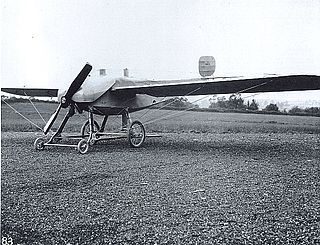
The Caproni Ca.1 was an Italian heavy bomber of the World War I era.

The Bristol Coanda Monoplanes were a series of monoplane trainers designed by the Romanian designer Henri Coandă for the British company British and Colonial Aeroplane Company.

The Caproni Ca.165 was an Italian biplane fighter developed just before World War II, but produced only as a prototype, as the competing Fiat CR.42 Falco was selected for series production.

The Caproni Ca.18 was a military reconnaissance aircraft built in Italy shortly prior to World War I. It became the first Italian-designed and -built aircraft to see service with the Italian armed forces. The Ca.18 was a monoplane of conventional configuration and fixed tailskid undercarriage. The wings were mounted to the fuselage with a bayonet fitting, to facilitate the rapid erection and dismantling of the aircraft.

The Caproni Ca.97 was a civil utility aircraft produced in Italy in the late 1920s and early 1930s. As originally designed, it was a high-wing braced trimotor monoplane of conventional configuration with one engine mounted on the nose and the other two carried on strut-mounted nacelles at the fuselage sides. Examples were also produced with only the nose engine or only the two nacelle-mounted engines.

The Caproni CH.1 was a single-seat biplane fighter, a single example of which was produced as a prototype in Italy in 1935.
The Caproni Ca.131 was a prototype for a large aircraft built in Italy in 1934, intended for use as either a bomber or airliner. It was a conventional low-wing cantilever monoplane, powered by a radial engine on each wing and in the nose. The main undercarriage was housed within large streamlined spats. Configured as an airliner, it would have seated 17 passengers.

The Caproni Ca.16 was a single-engine monoplane designed and built by Caproni in the early 1910s.
The Caproni Ca.10 was a single-engine monoplane designed and built by Caproni in the early 1910s.

The Caproni Ca.9 was a single-engine monoplane designed and built by Caproni in the early 1910s.
The Caproni Ca.25 was a single-engine monoplane made by the Italian company Aeronautica Caproni in 1914.

The Caproni Ca.11 was a single-engine monoplane designed and built by Caproni in the early 1910s.
The Caproni Ca.66 and Caproni Ca.67 were Italian night bomber aircraft designed to re-equip the post-World War I Regia Aeronautica.
The Caproni Ca.103 was a biplane twin-engine bomber developed by the Italian company Aeronautica Caproni in the late 1920s.

The Caproni Ca.105 was a multirole high wing single engine monoplane developed by the Italian aeronautical company Aeronautica Caproni in the late 1920s.
The Caproni Ca.120 was a three-engine monoplane bomber built by Caproni in the 1930s.
The Caproni Ca.142 was a three-engined multirole aircraft built by Caproni in the mid-1930s.
The Caproni Ca.146 was a high-wing reconnaissance aircraft built by Caproni in the mid-1930s.
The Caproni Ca.14 was an early biplane developed by Giovanni Battista Caproni in the early 1910s.

The Nieuport-Macchi Parasol was a single-engine observation aircraft produced by the Italian aeronautical company Nieuport-Macchi in the early 1910s. It was the first aircraft designed independently by Macchi, which until then had only produced aircraft under license. The Parasol operated in front-line service in 1915 during the early stages of Italy's participation in World War I.











